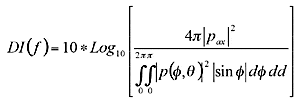
|

|
| This article was submitted by Tanya Arbogast, ScD, research audiologist, and Susan Whichard, MS, vice president of marketing at InSound Medical Inc, Newark, Calif. Correspondence can be addressed to Susan Whichard at . | |
Lyric is a new extended-wear, deep-canal, disposable device, offering 24/7 listening capabilities and 100% invisibility relative to cosmetics. It is also designed to provide solutions to many of the drawbacks encountered with traditional hearing aids, with significant acoustic, practical, and cosmetic benefits.
George1 indicates that only 21.4% of the estimated 28 million hearing-impaired Americans utilize amplification regularly. Although advancements in hearing instruments have improved customer satisfaction, issues with sound quality, feedback, limited frequency response, occlusion, pain or irritation in the fitting, moisture, social stigma, and cosmetic issues persist.2 Additionally, there are hassles of hearing aid ownership include routine daily insertion and removal, replacement of batteries, telephone and earphone usage, wind noise, problems associated with cerumen, and migration of the instrument. Traditional devices are restricted in use during daily activities such as sleeping, showering, or exercising. These and other practical frustrations are constant reminders of one’s hearing loss and communication deficit.
InSound Medical has developed a new category of hearing device designed specifically to address these issues. As a result of years of research and development, Lyric® was released into the market in 2008 as the first completely invisible, extended-wear, deep-canal hearing instrument (Figure 1).
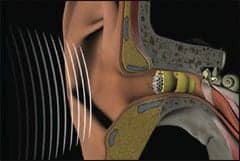
|
| FIGURE 1. Lyric hearing device by InSound Medical. |
The extended-wear feature provides the benefit of amplification on a round-the-clock basis for months at a time and freedom from multiple daily insertions/ removals, frequent battery changes, and cleaning. The deep-canal placement provides key acoustic benefits, as well as device imperceptibility. The Lyric’s microphone picks up sound several millimeters inside the ear canal, allowing the pinna and concha to transform sound naturally before entering the device for amplification. The Lyric’s receiver presents the amplified sound significantly closer to the tympanic membrane than traditional hearing aids, requiring less electronic gain. In addition, patients benefit from the unique ability to hear with Lyric 24/7 regardless of their activities and without disclosing their hearing loss to others.
This new hearing instrument is placed in the bony portion of the ear canal ~4 mm from the tympanic membrane by a trained audiologist, hearing aid dispenser, or ENT physician without the need for surgery or anesthesia. Lyric is available in multiple sizes to accommodate ear canals within a range of dimensions. The device is worn continuously (24/7) and requires no battery change for up to 120 days before device replacement. If required, it may be removed at any time by the patient or by the hearing care professional at their office.
The hearing instrument is purchased on a yearly subscription basis. A 1-year subscription includes all device replacements needed for the year. Lyric is removed and discarded when the battery is depleted or at 4 months, whichever comes first, and a new Lyric is inserted on the same day. Therefore, patients always receive the latest and best in Lyric technology during their subscription.
Device Characteristics and Technology
Lyric is designed with materials and components that deliver a high-quality hearing solution that can safely and comfortably withstand the rigors of the hostile ear canal environment for months at a time.
Seals. The device is retained in the ear canal by custom-engineered biocompatible, antimicrobial, breathable seals that have been demonstrated safe to wear continuously for months at a time.
Coating and mechanical designs. A proprietary coating technology and unique mechanical design were developed to protect the device from the challenging environment of the ear canal, including moisture, debris, and cerumen. The mechanical design provides for an insertion tab to mate with the clinician’s insertion forceps and a removal loop that allows the wearer to remove the device at any time with the aid of a safe removal tool.
Battery. A proprietary zinc air battery has an elliptical shape to fit comfortably inside the ear canal and maximize energy content. Combined with low-power electronics, and receiver placement close to the ear drum, the battery is designed to last up to 120 days. Device life varies with settings, usage patterns, and individual ear characteristics.
Signal processing. The Lyric uses analog sound processing for high fidelity and optimum power efficiency, enabling extended battery life. The acoustic advantages provided by the ultra-deep placement in the ear canal (discussed below) make analog technology the logical choice. The device is digitally programmable and can be programmed by the clinician via a non-contact programming wand. The volume is controlled by the user with a custom non-contact magnetic tool.
The Benefits of Deep-Canal Placement
Deeply fit (beyond the second bend) hearing instruments and earmolds are known to provide several benefits for the hearing instrument user, including an overall increase in gain and output, greater headroom, reduced occlusion effect, reduced feedback, and improved directionality.3-9 Unlike other nominally deep-fit instruments—typically CICs and RICs—the Lyric realizes all of the advantages of consistent deep placement of the entire device, not just the receiver. A CIC microphone is at best recessed 1-2 mm into the canal, sometimes less due to electronic space needs; the microphone on an RIC is located behind the ear, a less-than-ideal location. On the receiver end, a deep-fit RIC relies on proper and consistent patient insertion. The receiver on a CIC is not always deeply fit due to the challenge of taking the impression and wearing discomfort due to sensitivity and inflexibility in the bony portion of the canal.
With Lyric, a unique sizing and placement system allows for consistent placement by a trained professional at ~4 mm from the tympanic membrane without the need to take a deep ear impression. The microphone sits 4 mm or more inside the ear canal, deeper than any other device. Soft seals conform to the ear canal such that the device feels comfortable (and often “non-existent”) when properly positioned, even in the sensitive and inflexible bony portion of the ear canal.
Increased gain and output. The placement of Lyric provides increased gain and output for two reasons:
- The microphone is located several millimeters inside the ear canal, leaving the pinna and concha unobstructed; and
- The receiver is located approximately ~4 mm from the tympanic membrane resulting in less residual volume.
The acoustic effects of the pinna and concha provide a high-frequency boost to sound entering the ear canal.3,4,8,9 Figure 2 illustrates the comparative effects of microphone placement from that of a typical ITC, flush with the opening of the ear canal, and 2-3 mm inside the opening.7 The result is an average 5 dB increase between 2 and 5 kHz by moving the microphone from an ITC position to a few millimeters inside the canal. The difference between the microphone position on an ITE and CIC recessed 2 mm into the canal can be as large as 8 dB in the high frequencies.9

|
| FIGURE 2. Contribution of microphone placement. Data from Staab 19967. |
A stable and consistent receiver placement at ~4 mm from the tympanic membrane means that the residual volume between the output of the device and the ear drum is less compared to most hearing aids. In accordance with Boyle’s Law, lower volume results in increased pressure for a sealed, high acoustic impedance (ie, a hearing aid receiver driving a closed volume). The median residual volume for a standard-length earmold or hearing aid is 1.26cc, according to ANSI S3.25 or IEC 60711. Theoretically, the gain improvement from 1.26cc to 0.4cc is 20log10(1.26/0.4) = 9.96 dB. However, because the impedance of the tympanic membrane is frequency-dependent, the equivalent volume is greater at low frequencies, producing a smaller boost in gain.3,7 Calculated increases in gain are about 5 dB for low frequencies and between 9 dB and 12 dB for high frequencies.7 Figure 3 illustrates the increase in gain for the Lyric from a standard 2cc coupler to a 0.3cc ear simulator.

|
| FIGURE 3. Lyric frequency response. Blue indicates the calculated gain in a 0.3cc ear simulator and the red is gain measured in a standard 2cc coupler. |
Thus, in total, the Lyric’s deeply fit microphone and receiver can result in as much as 15-17 dB of additional gain in the high frequencies relative to a standard-length ITC device. Data published by Chasin,3 Preves,9 and Gudmundsen10 concur, averaging about a 5 dB gain for low frequencies (250-500 Hz) and 12 dB for high frequencies (2k-5kHz) for a deep-canal CIC. The increase in acoustical gain means that less amplification is required for the same output level, resulting in lower current drain and increased battery life.
Wide bandwidth. The Lyric design takes full acoustic advantage of both optimal microphone placement and deep receiver placement to provide a smooth, wide bandwidth response. As for headphones, telephones, and consumer audio devices, wider bandwidth equates to improved fidelity, better sound quality, and improved speech intelligibility.
Improved headroom. Hearing aid headroom is defined as the difference between the output of the hearing aid and the saturation of the instrument (SSPL90). As discussed above, Lyric operates in a smaller residual volume requiring less operating gain than other instruments to achieve the same results. Thus, with less operating gain relative to the overall saturation (SSPL90), the headroom in a deep fitting device such as Lyric can be greater than for traditional hearing aids. The benefits of greater headroom have been associated with less saturation-induced distortion and better overall sound quality,11,12 as well as allowing for greater output levels without reaching the patient’s uncomfortable loudness level.13,14
Reduced occlusion effect. An effective solution to the occlusion effect is to obtain a good seal in the bony portion of the ear canal, particularly when thresholds in the low frequencies are less than perfect and an open fit is not desired for its lack of low frequency gain. Deep-fit devices produce no perception and little to no objective measurement of the occlusion effect.5,15,16 The Lyric achieves a comfortable, form-fitting seal well within the bony portion of the ear canal and can provide significant low frequency gain if needed.
Reduced feedback. The deep fit and design of the Lyric reduce feedback on several fronts. The proximity of the receiver to the tympanic membrane decreases the amplification needed to reach target gain. Less output means less chance of feedback occurring. The acoustic seal of conventional devices seated in the cartilaginous portion of the canal is frequently compromised as jaw movement causes gaps and openings. The acoustic seal of Lyric is stable, even with jaw movement, because it occurs in the bony portion of the ear canal and is not dependent upon proper daily insertion by the patient. Therefore, feedback is less likely to occur. The lack of a perceptible occlusion effect also eliminates the need for significant venting, thus eliminating another common feedback path. The biocompatible seals of the Lyric conform to the shape of each ear canal, further reducing the chance of gaps as a feedback pathway.
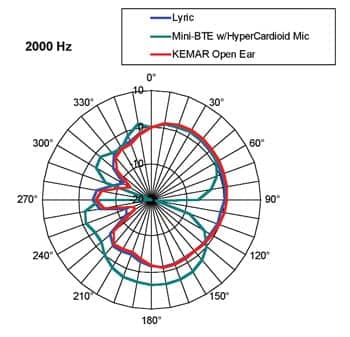
|
| FIGURE 4. Lyric directionality (blue) tracks the open canal (red) due to its optimal microphone placement. |
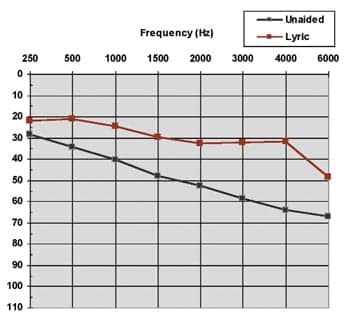
|
| FIGURE 5. Mean unaided and aided soundfield thresholds (n=74). Left and right ear thresholds were averaged because the results were very symmetrical. |
Directionality. The perception of sounds in space is important not only in terms of being aware of events and situations in one’s environment, but also in terms of sorting through complex auditory environments and being able to focus attention on a source of interest. Spatial perception is determined by interaural differences in time and level, as well as higher-frequency spectral cues produced when sound is filtered by the pinna before entering the ear canal.17,18 Although interaural time and level differences are not affected by microphone placement, they can be disrupted by complex signal processing, particularly when processing decisions are made independently within each hearing aid.19,20 Spectral cues that contribute to the perception of sound location largely arise from the interaction of sound with the pinna and concha. Hearing aids often disrupt spectral cues due to any combination of 1) obstruction of the concha; 2) placement of the microphone (eg, behind the pinna); and 3) limited bandwidth for higher frequency cues.
Listeners with sensorineural hearing loss cannot always use the cues that are available to them as effectively as listeners with normal hearing; therefore, it is important to preserve as many cues as possible. The placement of Lyric leaves the pinna, concha, and lateral portion of the ear canal completely unobstructed (up to 4 mm or more inside the ear canal) such that sound reaching the Lyric’s microphone has been transformed, as much as possible, as it would be in entering an unoccluded ear (Figure 4). The boost in high-frequency gain provided by the concha resonance and wide bandwidth of the device, as well as the receiver’s proximity to the tympanic membrane, enables more listeners to take advantage of higher-frequency spectral cues to spatial location. The optimal microphone placement of the device eliminates the need for complex directional processing, and is therefore less likely to disrupt natural interaural spatial cues. The availability of natural cues can help the patient sort through complex auditory environments, as well as contribute to the perception of natural sound quality.
Clinical Studies
Nearly 100 subjects participated in several clinical studies conducted between 2006 and 2008. Inclusion criteria were based on hearing loss, word recognition abilities, ear health, general health, and age. Only subjects with bilateral, mild to moderately severe sensorineural hearing loss with word recognition scores of at least 50% were allowed to participate. Age limits were set between 18 and 85 years. In addition, the subjects’ ear canals were indicated to wear Lyric in terms of size and shape bilaterally.
Mean audiometric data is provided in Figure 5. Individual configurations varied between flat, sloping, cookie bite, and high-frequency notch, but most configurations were sloping. The mean word recognition score measured with CID W-22 recorded materials at pb-max was 88% and ranged from 52% to 100% (N=98).
Results. Figure 5 also illustrates the mean improvement in soundfield thresholds from unaided to aided on the day of fitting. The average word recognition score for monosyllabic words presented in soundfield at a soft conversational level (45 dBHL) improved from 50% unaided to 91% aided on the day of fitting (N=75). For a group of subjects who owned traditional hearing aids (N=27), the mean word recognition score was higher for Lyric (87%) than for their traditional hearing aids (72%); however, the difference is not statistically significant. The mean unaided score for this group was 28%. (Authors’ Note: Testing with the subject’s own hearing aids in this case, as well as for the remainder of this article, was performed in “as is” condition: with the settings and in the condition with which the subject was using them as they walked into the clinic.)
The Abbreviated Profile of Hearing Aid Benefit (APHAB) questionnaire21 was administered prior to fitting and at 1 month post fitting. The APHAB consists of four subscales: Ease of Communication (EC), Reverberant Listening Conditions (RV), Background Noise (BN), and Aversiveness to Sounds (AV). Figure 6 shows the mean results for subjects comparing Lyric to the unaided condition, and Figure 7 compares Lyric to the subjects’ own aids.
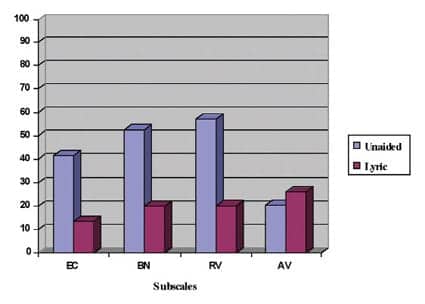
|
| FIGURE 6. Mean APHAB scores for unaided and Lyric (n=18). |
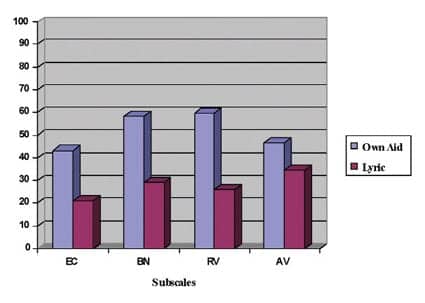
|
| FIGURE 7. Mean APHAB scores for own aid and Lyric (n=11). |
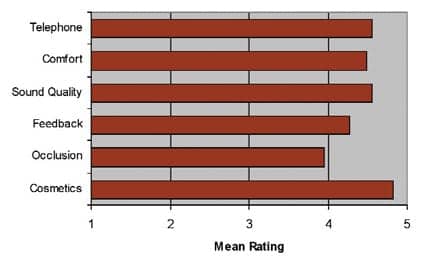
|
| FIGURE 8. Mean satisfaction ratings at 1 month post-fitting (N=55). |
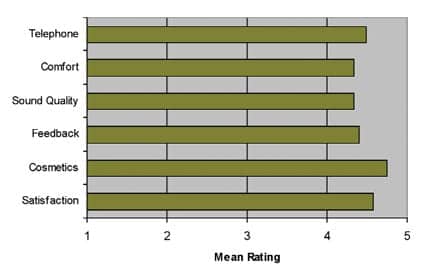
|
| FIGURE 9. Mean comparison questionnaire ratings (N=47) . |
Benefit scores relative to the unaided condition were 28 for EC, 32 for RV, and 36 for BN. Benefit scores relative to the subjects’ own hearing aids were 22 for EC, 29 for RV, and 34 for BN. Cox21 indicates that a difference of at least 10% on all three of the communication scales (EC, RV, and BN) indicates a significant difference when comparing one condition to another. In both cases, the APHAB results indicate that Lyric provides a significant benefit over the unaided condition as well as the subject’s own hearing aids.
Subjects filled out a satisfaction questionnaire at 1 month post fitting, and were asked to rate their satisfaction with Lyric in terms of cosmetic appearance, frequency of occlusion, frequency of feedback, sound quality, comfort, and telephone use. The ratings were on a 5-point Likert scale with 1 = Very Dissatisfied, Very Unclear (for sound quality), or Very Often (for occlusion/feedback); 3 = Neutral; and 5 = Very Satisfied, Very Clear (sound quality), or Never (occlusion/feedback). Figure 8 shows the mean ratings for each question.
Subjects who owned hearing aids were asked to fill out an additional questionnaire comparing Lyric to their own hearing aids in terms of overall satisfaction, appearance, frequency of feedback, sound quality, comfort, and telephone use. Ratings were on a 5-point Likert scale with 1 = Much Worse (Lyric being much worse); 3 = Same; and 5 = Much Better (Lyric being much better). Figure 9 shows the mean ratings for each question.
With the introduction of this new category of hearing device, a completely new option is now available for those with hearing loss. Lyric is designed to provide a solution to many of the drawbacks encountered with traditional hearing aids, with significant acoustic, practical, and cosmetic benefits.
References
- George L. Report of the Medical Technology Assessment Working Group. Duke University, Durham, NC; 2006. Available at: www.medicalnewstoday.com/articles/44479.php.
- Strom KE. HR Interviews … Sergei Kochkin. Hearing Review. 2005;12(10):24-32,82. Available at: www.hearingreview.com/issues/articles/2005-10_03.asp.
- Chasin M. The acoustic advantages of CIC hearing aids. Hear Jour. 1994;47(11):13-17.
- Agnew J. Acoustic advantages of deep canal hearing aid fittings. Hearing Instrum. 1994;45:22-25.
- Staab W. Solving challenges in deep canal fittings, Part 1. Hearing Review. 1995;2(2):34-40.
- Staab W. Solving challenges in deep canal fittings, Part 2. Hearing Review. 1995;2(2):30-34.
- Staab W. Introduction to deep canal principles. Sem Hear. 1996;17(1):3-20.
- Mueller HG, Ebinger K. CIC hearing aids: Potential benefits and fitting strategies. Sem Hear. 1996;17(1):61-80.
- Preves D. Real-ear gain provided by CIC, ITC, and ITE hearing instruments. Hearing Review. 1994;1(7):22-24.
- Gudmundsen GI. Fitting CIC hearing aids—Some practical pointers. Hear Jour. 1994;47(11):10,46-49.
- Agnew J. Hearing instrument distortion: What does it mean for the listener? Hearing Instrum. 1988;39:10-20.
- Preves D, Woodruff BD. Some methods of improving and assessing hearing aid headroom. Audecibel. 1990;38:8-13.
- Fortune T, Preves D, Woodruff BD. Saturation induced distortion and its effects on aided LDL. Hearing Instrum. 1991;42:40-41.
- Fortune T, Preves D. Hearing aid saturation and loudness discomfort. J Sp Hear Res. 1992;35:175-185.
- Mueller HG. CIC hearing aids: What is their impact on the occlusion effect? Hear Jour. 1994;47(11):29-36.
- Killion MC, Wilber LA, Gudmundsen GI. Zwislocki was right… Hearing Instrum. 1988;39:14-18.
- Blauert J. Spatial Hearing, The Psychophysics of Human Sound Localization. Cambridge, Mass: MIT Press; 1997:67-69,138.
- Moore BCJ. An Introduction to the Psychology of Hearing. San Diego: Academic Press; 1989;195, 204-206.
- Van den Bogaert T, Doclo S, Wouters J, Moonen M. The effect of multimicrophone noise reduction systems on sound source localization by users of binaural hearing aids. J Acoust Soc Am. 2008;124(1):484-497.
- Van den Bogaert T, Klasen TJ, Moonen M, Van Deun L, Wouters J. Horizontal localization with bilateral hearing aids: Without is better than with. J Acoust Soc Am. 2006; 119(1):515-526.
- Cox RM, Alexander SC. The abbreviated profile of hearing aid benefit. Ear Hear. 1995;16:176-186.
Citation for this article:
Arbogast T, Whichard S. A New Hearing Aid Class: The First 100% Invisible Extended-Wear Hearing Aid Hearing Review. 2009;16(4):20-27.





